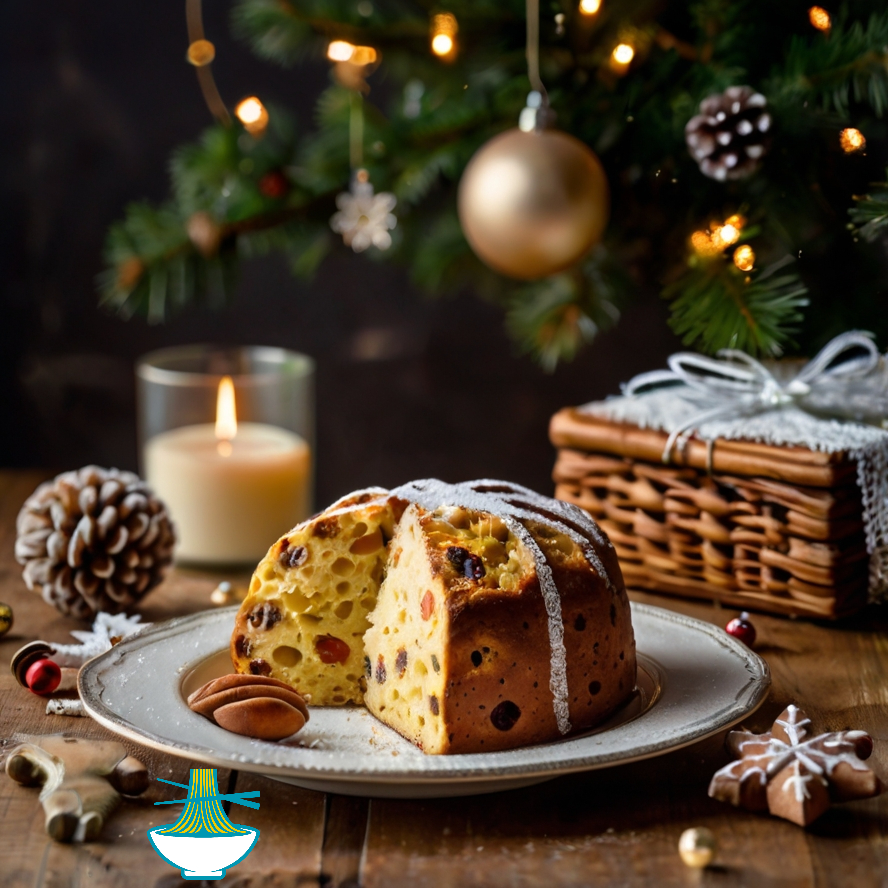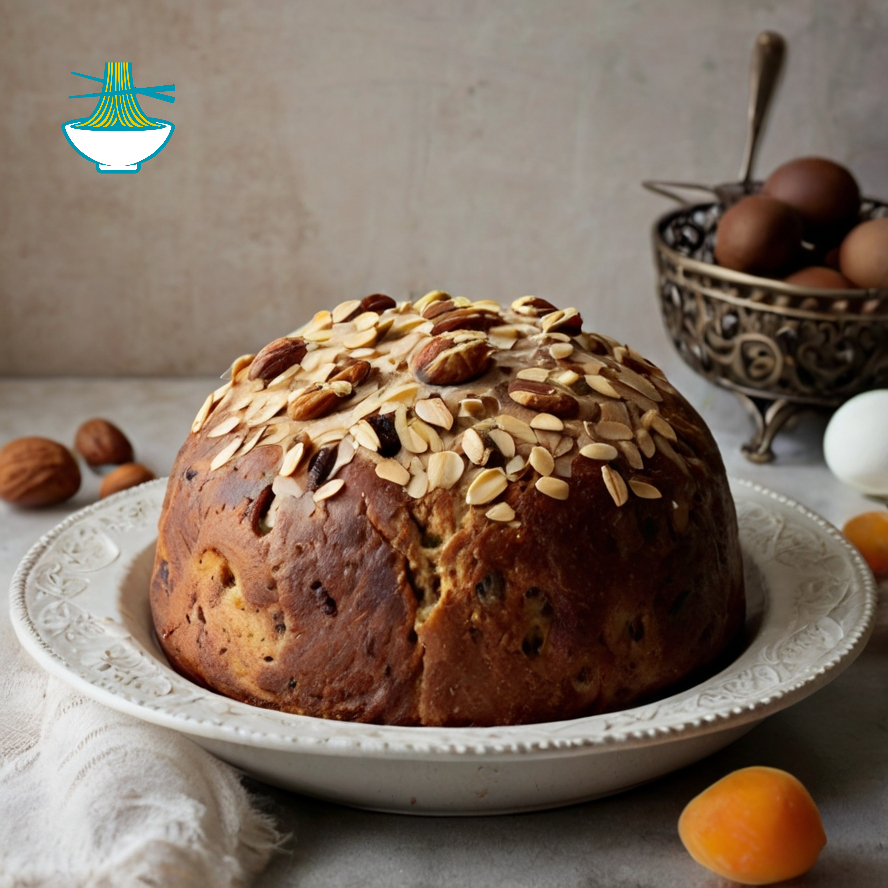Panettone is a traditional Italian sweet bread, perfect for celebrating Merry Christmas with its light, fluffy texture and delightful blend of dried fruits and nuts. This festive treat not only brings joy to your celebrations but also offers a healthier twist for foodies looking to enjoy a nutritious dessert. With essential vitamins and minerals like Vitamin A for immunity, Vitamin E for skin health, iron for energy, and magnesium for muscle function, this panettone is a delicious, guilt-free option to indulge in during the holiday season. Whether shared at Christmas dinner or gifted to loved ones, it combines festive flavor with health benefits, making it a perfect addition to your Christmas table.
Ingredients:
- 500 grams bread flour (can be substituted with whole wheat flour for a healthier option)
- 100 grams sugar (can be substituted with 80 grams honey or 60 grams coconut sugar for a healthier option)
- 200 grams butter (can be replaced with 200 grams coconut oil or 180 grams plant-based butter)
- 3 eggs (can be substituted with 3 tablespoons ground flax seeds mixed with 9 tablespoons water as a vegan alternative)
- 10 grams active dry yeast (can be replaced with 30 grams fresh yeast)
- 100 grams milk (can be substituted with almond milk or coconut milk for a lactose-free option)
- 1 teaspoon vanilla extract (optional: can use natural vanilla extract or replace with almond extract)
- 1 teaspoon grated orange zest (optional: can replace with lemon zest for a different flavor)
- 200 grams dried fruits (such as raisins, dates, or dried apricots)
- 50 grams chopped nuts (such as walnuts or almonds – can be substituted with more affordable nuts like peanuts or sunflower seeds)
Preparation Steps:
1. Prepare the dough:
- In a large bowl, combine 500 grams of bread flour (can be substituted with whole wheat flour for a healthier choice).
- Add 100 grams of sugar (can be replaced with honey or coconut sugar) and 10 grams of active dry yeast, then mix the dry ingredients well.
2. Mix the wet ingredients:
- In another bowl, beat 3 eggs (or flaxseed mixture if using a vegan alternative).
- Heat 100 grams of milk (or almond or coconut milk) until lukewarm, then add it to the eggs.
- Add 200 grams of butter (or melted coconut oil) to the mixture, and stir in 1 teaspoon of vanilla extract (or almond extract).
3. Combine the wet and dry ingredients:
- Pour the wet mixture into the dry ingredients and start kneading the dough with your hands or a wooden spoon until a smooth dough forms. If the dough is too sticky, add a little more flour.
4. First rise:
- Cover the dough with plastic wrap or a damp cloth and let it rise in a warm place for about an hour or until it doubles in size.
5. Add the fruits and nuts:
- After the dough has risen, fold in 200 grams of dried fruits (such as raisins, dates, or dried apricots) and 50 grams of chopped nuts. Mix them into the dough evenly.
6. Second rise:
- Place the dough in a greased round cake pan or panettone mold, and let it rise again for about 30 minutes until it doubles in size.
7. Baking:
- Preheat the oven to 180°C (350°F). Bake the panettone for 40-50 minutes, or until golden brown and a skewer inserted into the center comes out clean.
8. Cooling and serving:
- Allow the panettone to cool completely before slicing and serving. You can dust it with powdered sugar or drizzle dark chocolate sauce for an extra touch.
Tips for Adding Extra Healthy Flavors:
- Spices: You can enhance the flavor by adding a pinch of cinnamon or ground cardamom to the dough. These spices provide a warm, rich flavor without extra sugar.
- Using kitchen tools effectively: To ensure perfect results, it's recommended to use a kitchen scale to measure ingredients precisely, especially when using substitutes like flour or natural sweeteners. Also, make sure to use sturdy baking molds to ensure an even bake and well-formed panettone.
- Fruits and Nuts: Feel free to vary the dried fruits depending on what you have available, such as adding dried apple pieces or dried peaches. Nuts like walnuts or almonds give the panettone a crunchy texture and boost its nutritional value.
By following these steps, you'll be able to make a delicious and healthier panettone, with substitutes that suit various dietary needs.
Frequently Asked Questions (FAQ) about Panettone Recipe
1. Can I make Panettone without a mold?
Yes, you can still make panettone without a traditional panettone mold. If you don't have one, you can use a tall round cake pan or a coffee can (lined with parchment paper) to shape the dough. Just ensure that the dough has enough room to rise and expand. Another option is to form the dough into a round loaf and place it on a parchment-lined baking sheet. While the shape might differ slightly, the panettone will still bake beautifully.
2. How do I make my Panettone fluffier?
To achieve a fluffier panettone, it's essential to give the dough time to rise properly. A slow, long fermentation process works best for creating light and airy bread. After the initial kneading, let the dough rest for 1-2 hours for the first rise, and then allow it to rise again after you’ve added the dried fruits and nuts. You can also add a small amount of vital wheat gluten to the dough to help the structure and elasticity, contributing to a fluffier texture.
3. Can I use fresh fruit instead of dried fruit in Panettone?
While dried fruits such as raisins, currants, and candied citrus peel are traditional in panettone, fresh fruit is not recommended because it can introduce excess moisture, which may affect the texture and structure of the bread. If you prefer fresh fruit, consider dehydrating it first, or use fruit preserves or fruit compote as an alternative to add the fruity flavor without compromising the bread's texture.
4. How can I store Panettone to keep it fresh longer?
Panettone tends to dry out quickly after baking, so it's important to store it properly to keep it fresh. To maximize freshness, wrap the panettone tightly in plastic wrap and then place it in an airtight container or a resealable plastic bag. You can also freeze the panettone for up to 3 months. If freezing, make sure it's tightly wrapped to prevent freezer burn. To thaw, simply leave it at room temperature for a few hours.
5. Can I add chocolate to Panettone?
Yes, you can add chocolate to your panettone! For a chocolate twist, fold in small chunks of dark chocolate, chocolate chips, or cocoa nibs along with the dried fruits and nuts. Another option is to drizzle melted dark chocolate over the cooled panettone for a decadent finish. Just be sure not to overdo it with the chocolate, as it could overpower the delicate flavor of the bread.
Nutrition Value:
1. 500 grams Bread Flour
- Calories: 1,800 kcal
- Carbohydrates: 375 g
- Protein: 60 g
- Fat: 6 g
- Sodium: 0 mg
- Cholesterol: 0 mg
- Vitamins: Small amounts of B-vitamins (especially thiamine and niacin)
- Minerals: Iron, calcium, magnesium
- Nutritional Benefit: Bread flour provides a high carbohydrate content, which is a great energy source. It also contains small amounts of B-vitamins that help in energy metabolism.
2. 100 grams Sugar
- Calories: 387 kcal
- Carbohydrates: 100 g
- Protein: 0 g
- Fat: 0 g
- Sodium: 0 mg
- Cholesterol: 0 mg
- Vitamins: Minimal, with slight traces of B-vitamins
- Minerals: Calcium, potassium
- Nutritional Benefit: Sugar provides a quick energy source but is low in nutrients. It offers a simple, fast-burning energy source.
3. 200 grams Butter
- Calories: 1,430 kcal
- Carbohydrates: 0 g
- Protein: 0 g
- Fat: 160 g (of which 100 g are saturated fats)
- Sodium: 380 mg
- Cholesterol: 160 mg
- Vitamins: Vitamin A, Vitamin D
- Minerals: Calcium
- Nutritional Benefit: Butter adds flavor and moisture to the panettone, but due to its high saturated fat content, it’s important to consume in moderation. It also provides essential vitamins like Vitamin A and D for immune health.
4. 3 Eggs
- Calories: 210 kcal
- Carbohydrates: 1.5 g
- Protein: 18 g
- Fat: 15 g (mainly healthy fats)
- Sodium: 210 mg
- Cholesterol: 560 mg
- Vitamins: Vitamin A, Vitamin D, Vitamin B12, Folate
- Minerals: Iron, calcium, phosphorus, potassium
- Nutritional Benefit: Eggs provide high-quality protein, essential vitamins like B12 and D, and antioxidants, which are vital for immune health and energy production.
5. 10 grams Active Dry Yeast
- Calories: 30 kcal
- Carbohydrates: 3 g
- Protein: 3 g
- Fat: 0 g
- Sodium: 0 mg
- Cholesterol: 0 mg
- Vitamins: B vitamins, especially B1, B2, B3, and B6
- Minerals: Iron, potassium
- Nutritional Benefit: Yeast helps the dough rise and provides essential B vitamins that support energy production and metabolic function.
6. 100 grams Milk
- Calories: 61 kcal
- Carbohydrates: 5 g
- Protein: 3.2 g
- Fat: 3.3 g
- Sodium: 44 mg
- Cholesterol: 10 mg
- Vitamins: Vitamin A, Vitamin D, Vitamin B12, Riboflavin
- Minerals: Calcium, phosphorus, magnesium
- Nutritional Benefit: Milk provides protein, calcium, and essential vitamins. It supports bone health, muscle function, and the immune system.
7. 1 teaspoon Vanilla Extract
- Calories: 12 kcal
- Carbohydrates: 0.5 g
- Protein: 0 g
- Fat: 0 g
- Sodium: 0 mg
- Cholesterol: 0 mg
- Vitamins: None significant
- Minerals: None significant
- Nutritional Benefit: Vanilla adds flavor without contributing significant nutrients, but it enhances the overall sensory experience with its aromatic richness.
8. 1 teaspoon Grated Orange Zest
- Calories: 6 kcal
- Carbohydrates: 1.5 g
- Protein: 0 g
- Fat: 0 g
- Sodium: 0 mg
- Cholesterol: 0 mg
- Vitamins: Vitamin C (high)
- Minerals: Potassium, calcium
- Nutritional Benefit: Orange zest adds a burst of Vitamin C, an essential antioxidant that supports immune health, skin function, and collagen production.
9. 200 grams Dried Fruits (such as raisins, dates, or dried apricots)
- Calories: 500-600 kcal (depending on the type of fruit)
- Carbohydrates: 130 g
- Protein: 4 g
- Fat: 0-2 g
- Sodium: 10 mg
- Cholesterol: 0 mg
- Vitamins: Vitamin A, Vitamin C (in dried apricots), Vitamin K
- Minerals: Potassium, iron, magnesium, calcium
- Nutritional Benefit: Dried fruits provide natural sweetness, fiber, and important minerals like potassium and iron, which support heart, digestive health, and energy levels.
10. 50 grams Chopped Nuts (such as walnuts or almonds)
- Calories: 300 kcal
- Carbohydrates: 10 g
- Protein: 10 g
- Fat: 25 g (mostly healthy fats)
- Sodium: 0 mg
- Cholesterol: 0 mg
- Vitamins: Vitamin E, B-vitamins, Vitamin A (especially in almonds)
- Minerals: Magnesium, potassium, iron, zinc
- Nutritional Benefit: Nuts are rich in healthy fats, protein, and antioxidants, supporting heart health, reducing inflammation, and promoting brain function.


Comments